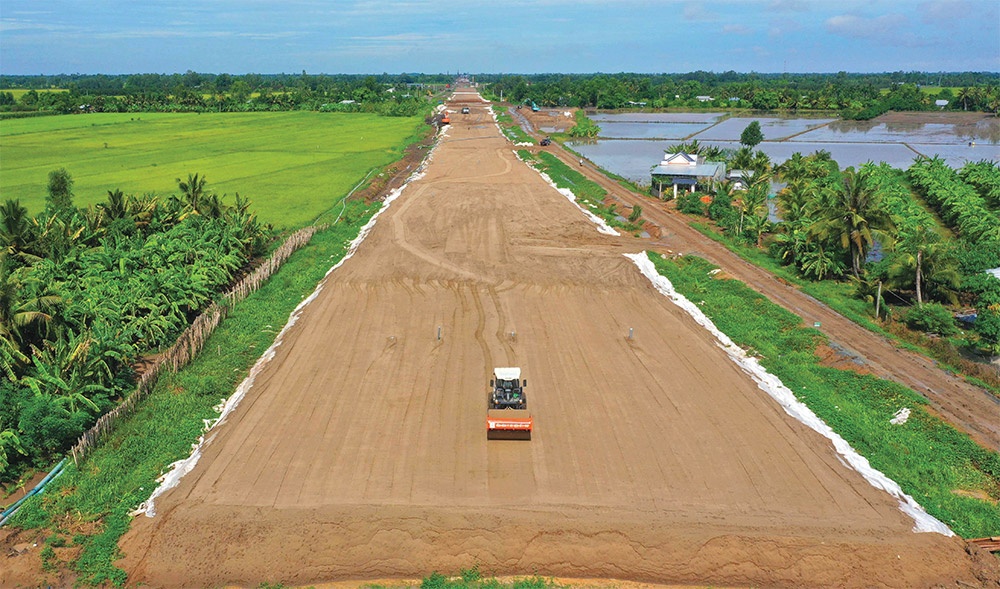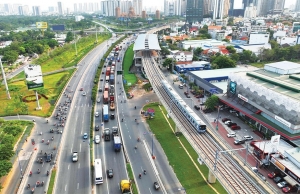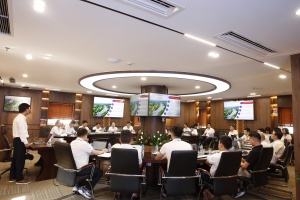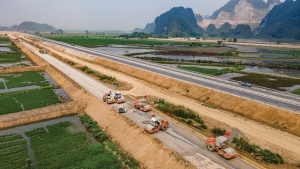Infrastructure importance emphasised for growth goals
 |
| A handful of national key projects are under construction, with some to be completed next year, Photo Le Toan |
At last week’s meeting with constituents in the Mekong Delta city of Can Tho, Prime Minister Pham Minh Chinh said that based on the positive economic trends since early this year, the government has decided to pursue a higher-than-expected economic growth target for this year.
“At the government’s cabinet meeting on socioeconomic development for June and its hybrid meeting with local leaders, we have determined that the country’s economic growth for the whole of 2024 will be about 7 per cent,” PM Chinh said.
This new target exceeds the initial goal of 6-6.5 per cent set earlier this year by the National Assembly and the government. PM Chinh instructed the Ministry of Planning and Investment to continue updating new growth scenarios for Q3, Q4, and the entire year.
“To achieve this new growth target, we have identified 10 groups of tasks and solutions to be implemented,” PM Chinh said.
“One of them is increased investment in developing infrastructure projects. We will accelerate key projects and effectively implement a programme to complete construction of expressway projects within about 500 days, aiming for completion by late 2025.”
“Additionally, another solution is to continue accelerating administrative reforms to benefit the public and enterprises. Any unnecessary procedures that hinder enterprises must be promptly removed to further enhance a business-friendly environment.”
Infrastructure development
The ASEAN Investment Report 2023, released by the ASEAN Secretariat last year, highlighted Vietnam’s efforts to attract investors to infrastructure development such as roads, highways, logistics, and seaports.
“Vietnam is now open to the private sector with programmes aimed at attracting investment and engaging private sector partners in infrastructure development,” the report stated. “In 2021, for instance, Vietnam’s Ministry of Transport announced its transport infrastructure master plan for the decade, estimated to cost between $39.4 billion and $62 billion.”
“Under this plan, Vietnam plans to construct thousands of miles of new expressways, high-speed rail routes, deepwater ports, and new international airports. The government aims for a cargo transportation capacity of 4.4 billion tonnes per year and a road transport capacity capable of moving 2.76 billion tonnes of cargo and 9.43 million passengers annually. Two major projects, the Dau Giay-Tan Phu Expressway and the Gia Nghia-Chon Thanh Expressway, will be built using the public-private partnership model.”
In the afternoon of July 13, PM Chinh met with leaders of 13 localities in the Mekong Delta region to discuss boosting strategic infrastructure development in the region, where GDP is estimated to currently amount to more than $41.7 billion, nearly 10 per cent of the national GDP.
Five national key road projects are underway in the region, including the Can Tho-Ca Mau section of the eastern north-south expressway, the Chau Doc-Can Tho-Soc Trang expressway, the Cao Lanh-An Huu expressway, the My An-Cao Lanh expressway (with procedures nearing completion, construction scheduled to begin in early 2025), and sections of the Ho Chi Minh expressway such as Rach Soi-Ben Nhat and Go Quao-Vinh Thuan.
“So far, four of the five projects have completed investment procedures and are under construction,” a Government Office document released last week stated.
“PM Chinh has underscored that the Mekong Delta region must have 600 kilometres of expressways by 2025 and 1,200 by 2030. Construction deadlines have been assigned for each project, with a focus on both north-south and east-west corridors.”
Following budget approval by the legislature, the prime minister approved a capital allocation plan of $28.7 billion to continue building infrastructure and driving economic development.
The Asian Development Bank (ADB) emphasised that public investment, primarily focused on infrastructure development, is a critical engine of economic growth, but highlighted the importance of executing plans to fully leverage this engine.
The ADB cited the Ministry of Planning and Investment’s calculation that a 1 per cent increase in public investment disbursement corresponds to a 0.058 per cent increase in GDP growth. Moreover, every $1 of disbursed public investment capital stimulates $1.61 of investment capital from the non-state sector.
“However, the execution rate compared to planned investment has consistently been low, hovering around 80 per cent from 2022 to 2024 so far. While the government has made efforts to address this issue, progress has been insufficient,” the ADB noted.
According to the ADB, projects sometimes require design or budget changes even after approval and budget allocation. This can cause long interruptions before work can start. One major obstacle to timely and quality preparation is the complexity of regulations, particularly land use planning, land acquisition, and site clearance.
Tasks assigned
The government has tasked the Ministry of Transport (MoT) to collaborate with authorised agencies and localities to develop infrastructure projects, predominantly roads and ports.
“Disbursement of public investment, including infrastructure development, must be considered a pivotal political task,” said the resolution of the government’s cabinet meeting for June released over a week ago. “This will help attract more private investment, especially foreign investment, under the public-private partnership model.”
The government has instructed the MoT to work with the Ministry of Natural Resources and Environment, the Ministry of Industry and Trade, the Commission for the Management of State Capital at Enterprises, and relevant agencies and localities to address challenges in site clearance, resettlement support, and ensuring adequate materials for projects, particularly in the Mekong Delta region.
At last week’s meeting of the government’s Steering Committee on Administrative Reform, where he serves as the head, PM Chinh emphasised that, in addition to boosting infrastructure development, the government, authorised agencies, and localities must “review and revise all regulations and remove legal barriers to mobilise all possible resources at home and abroad to serve national development.”
“More dialogues must be organised to assist enterprises in overcoming difficulties. More anti-corruption activities must be launched, alongside the development of e-government and e-society with digital data and non-cash payments promoted across all sectors and transaction types,” PM Chinh said.
In the first half of 2024, 168 business regulations and 247 administrative procedures were simplified or eliminated. Nearly 140 officials and 1,200 state officers were disciplined.
 | Infrastructure focus sets stage for real estate bonanza Although infrastructure development in Vietnam’s biggest cities is gradually helping to bolster real estate in neighbouring areas and push up prices, investors are advised to remain cautious and take local livelihoods into account. |
 | DEOCA Group pioneers transport infrastructure training with foreign universities DEOCA Group is known for its transportation infrastructure and pioneering human development strategies. |
 | Infrastructure firms eye rosier prospects The government's commitment to accelerate public investment offers bright development prospects for infrastructure developers. |
What the stars mean:
★ Poor ★ ★ Promising ★★★ Good ★★★★ Very good ★★★★★ Exceptional
Related Contents
Latest News
More News
- Strengthening supply chains through trade promotions and customs reform (December 24, 2025 | 14:00)
- PM orders investment model for North–South high-speed rail (December 22, 2025 | 17:43)
- LS Eco Energy to invest in Vietnam rare earth sector (December 22, 2025 | 17:31)
- Government moves to establish International Financial Centre (December 21, 2025 | 21:00)
- Vietnam's IFC to target global investment flows (December 21, 2025 | 18:00)
- Two national hospitals expand capacity with new facilities (December 20, 2025 | 09:00)
- Ha Tinh breaks ground on major Vingroup industrial and energy projects (December 19, 2025 | 18:24)
- EVN launches major power infrastructure projects nationwide (December 19, 2025 | 18:17)
- VAL inaugurates second production line to meet domestic animal feed demand (December 19, 2025 | 16:37)
- Sun Group pioneers urban tram system in Phu Quoc (December 19, 2025 | 15:00)

 Tag:
Tag:






















 Mobile Version
Mobile Version